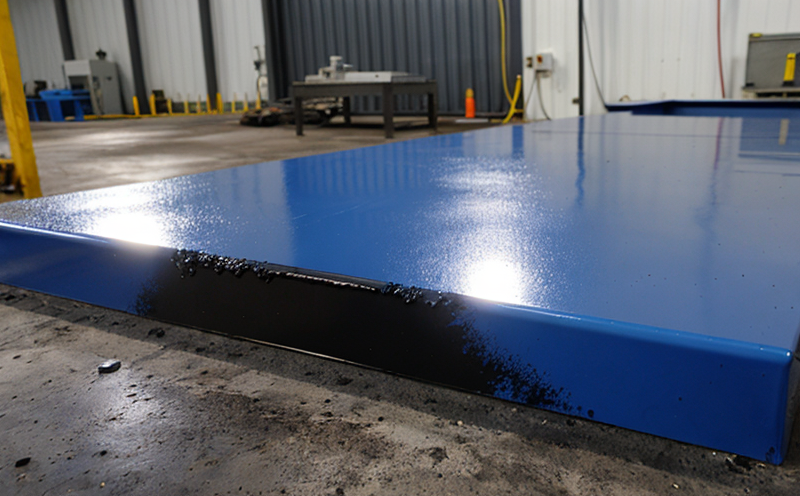ASTM D4541 Pull Off Adhesion Testing of Coatings Validation Method Development Test
The ASTM D4541 standard is a widely recognized method used in the field of metallurgy and material testing for validating the adhesion strength of surface coatings. This test plays a crucial role in ensuring that coatings applied to various substrates, such as metals or plastics, meet quality standards and perform reliably under real-world conditions.
The pull-off adhesion test measures the force required to peel a coated sample from its substrate at a controlled rate. The method is particularly important for industries where coating integrity is paramount, including automotive manufacturing, aerospace, construction, and electronics. By validating the adherence of coatings through this standardized procedure, manufacturers can ensure product reliability and durability.
The ASTM D4541 test involves several key steps. Specimens are prepared by applying a layer of the coating to a substrate, typically steel or aluminum plates. The coated samples are then cured according to manufacturer specifications before undergoing testing. During the pull-off adhesion test, the sample is mounted on a fixture and subjected to a controlled force until failure occurs. The force at which this happens is recorded as the adhesion strength of the coating.
Understanding the factors that influence the outcome of ASTM D4541 tests is essential for accurate interpretation. These include the type of coating used, the surface preparation of the substrate, and environmental conditions during testing. Proper specimen preparation ensures consistent results across multiple samples, which are crucial for validating the method's reliability.
The process begins with thorough cleaning and degreasing of the substrate to remove any contaminants that could affect adhesion performance. Once prepared, the coating is applied following established procedures and allowed to cure according to the manufacturer’s guidelines. Specimens are then cut to standard sizes suitable for testing, ensuring uniformity across all samples.
Instrumentation used in ASTM D4541 tests includes a universal testing machine equipped with appropriate fixtures capable of applying precise forces at a controlled rate. The force application is typically performed using a hydraulic or pneumatic system designed to ensure consistent and accurate measurements.
The results from these tests are critical for quality assurance purposes, helping manufacturers identify potential issues early in the production process. By validating the adhesion strength through ASTM D4541 testing, companies can avoid costly rework and improve overall product performance.
In summary, the ASTM D4541 pull-off adhesion test is a vital tool for ensuring that surface coatings applied to various substrates meet required standards. Its application in industries ranging from automotive to aerospace underscores its importance as an essential quality control measure.
Applied Standards
| Standard | Description |
|---|---|
| ASTM D4541-20 | This standard specifies the procedure for determining the adhesion of coatings to substrates by means of pull-off tests. It provides guidelines on specimen preparation, test methods, and evaluation criteria. |
| ISO 4629:2017 | An international equivalent that also covers the determination of adhesion using peel or shear testing. However, it focuses more broadly on various types of adhesion tests rather than specifically pull-off methods. |
| EN ISO 4629-1:2018 | The European standard that aligns closely with ASTM D4541 and ISO standards for the determination of adhesion, emphasizing the importance of consistent test procedures across different regions. |
The application of these standards ensures uniformity in testing protocols, facilitating comparability of results between laboratories worldwide. Compliance with these guidelines is crucial not only for quality control but also for regulatory compliance and international trade.
Benefits
Conducting ASTM D4541 pull-off adhesion tests offers numerous benefits across various sectors:
- Enhanced Quality Assurance: Ensures that coatings adhere properly to substrates, minimizing the risk of delamination or failure.
- Informed Decision Making: Provides valuable data for R&D teams to refine coating formulations and improve product performance.
- Regulatory Compliance: Helps businesses meet industry-specific requirements and standards, ensuring legal adherence.
- Improved Product Reliability: Identifies potential weaknesses early in the manufacturing process, allowing for timely corrective actions.
- Cost Savings: By preventing defective products from reaching end-users, companies can reduce warranty claims and associated costs.
The results of these tests are instrumental in maintaining high-quality standards across industries. The insights gained contribute significantly to the development of more robust coatings that enhance product longevity and performance.
International Acceptance and Recognition
The ASTM D4541 standard enjoys widespread recognition and acceptance internationally, particularly within sectors like metallurgy and material testing. Its adoption by multiple standards organizations ensures broad applicability and reliability:
- American Society for Testing and Materials (ASTM): A leading authority in materials science and engineering.
- International Organization for Standardization (ISO): Recognized globally for its role in developing international standards.
- European Committee for Standardization (CEN): Provides a platform for harmonizing technical specifications across Europe.
The consistency and reliability of ASTM D4541 tests contribute to their global acceptance. Laboratories accredited according to these standards are trusted by clients worldwide, ensuring consistent quality in testing services.





